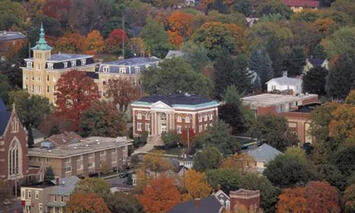
I’ve always been intrigued by the role of universities in the growth and development of cities. It’s well known that universities can have an outsized role on smaller towns and cities, helping them to outperform similarly sized cities in terms of economic opportunity and quality of life. Universities can have a huge impact, whether they are a large public flagship institution in a small or midsize city, or a small liberal arts college in a tiny hamlet.
It’s no mystery that the cities that have made the biggest urban revitalization leaps over the last 25-30 years have had footholds in economic sectors that were poised to grow our contemporary economy, like tech, finance, media, biomedical sciences and entertainment. Yet it’s also no mystery that cities near some of the best universities in the nation have used that proximity to attract high-level talent and feed the local talent pipeline. There’s a symbiotic relationship between New York City and Columbia and NYU, for example; Boston, Harvard and MIT; the Bay Area and UC-Berkeley and Stanford. This relationship is a defining feature of today’s economy.
Clearly that relationship works in some places. But it’s also clear that there are examples where it hasn’t. There’s an open question as to whether Ivies like Penn or Yale have made the same impact on Philadelphia and New Haven, respectively. That also applies to “Ivy Plus” schools like the University of Chicago and Northwestern in Chicago, Johns Hopkins in Baltimore, and Washington University in St. Louis.
So I’ve always wondered about the “town-gown” relationship. Is this relationship crucial for urban transformation? Why does the relationship work in some cities, and come up short in others? Do private and public universities have different impacts on cities? Does size (of the institution) matter? Will a city lacking such a relationship always lag those that do?
I can explain through my own experience. I worked on two projects designed to engage universities in community revitalization. As a planner for the City of Chicago at the start of my career, I worked on the Mid-South Plan, which looked at the redevelopment of the city’s Bronzeville neighborhood. Bronzeville can be called the point of origin for Black Chicago; an influx of Black migrants from the South, seeking to escape Jim Crow and take on good-paying manufacturing jobs, poured into the city starting in the late 19th century. In short time the area became the starting point of the Black Belt, the limited area of the South Side where Blacks were forced to live. Overcrowding in Bronzeville later led to the deliberate containment policy that was public housing. Bronzeville went through a half-century long downward spiral before the city took an earnest look at how to revitalize the area in the early 1990’s.
The Illinois Institute of Technology (IIT), a small, mostly post-graduate institution on the South Side, played a role in the planning effort. Since its founding in 1940, IIT’s been a presence in Bronzeville. But for decades the school was disconnected from the surrounding community, so it wasn’t always viewed favorably by its mostly Black neighborhood. IIT was trying to figure out how to effectively engage with the Bronzeville neighborhood and address its needs, while also securing its own presence. That made community engagement tough at the time.
Read the rest of this piece at The Corner Side Yard.
Pete Saunders is a writer and researcher whose work focuses on urbanism and public policy. Pete has been the editor/publisher of the Corner Side Yard, an urbanist blog, since 2012. Pete is also an urban affairs contributor to Forbes Magazine's online platform. Pete's writings have been published widely in traditional and internet media outlets, including the feature article in the December 2018 issue of Planning Magazine. Pete has more than twenty years' experience in planning, economic development, and community development, with stops in the public, private and non-profit sectors. He lives in Chicago.
Photo: North Central College, a small private college adjacent to downtown Naperville, IL, is a community anchor that has played a key role in the growth of the entire Naperville community. courtesy The Corner Side Yard.













exempt
One thing they surely do is take large parcels off the tax rolls.